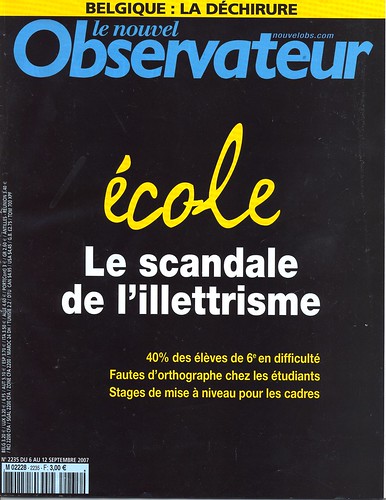4. Une orthographe ardue
Pas de chance pour les écoliers français. Notre orthographe est l’une des plus difficiles au monde. Pour une raison bête comme chou. Ce n’est pas parce qu’on entend un son qu’on saura l’écrire (« saint » se prononce comme « ceint », « sein » ou « sain », etc.) Les linguistes parlent de régularité entre les sons et les lettres. D’un pays a l’autre, elle varie du simple au double. Elle est de 97%, par exemple, pour l’espagnol ou l’italien, de 98-99% pour le finlandais ou le danois, mais seulement de 55% pour le français. Sans parler des problèmes d’accord, de lettres qui ne sont pas prononcées. De quoi s’arracher les cheveux. Là où un petit Espagnol mettra quelques mois à maîtriser les bases orthographiques, il faudra des années pour un Français. C’est que, dans beaucoup de pays, l’orthographe s’est simplifiée, « phonetisée », au fil des siècles. En France, non. « Notre langue est très conservatrice », reconnaît le linguiste Alain Bentolila, qui vient de publier « Urgence école : le droit d’apprendre, le devoir de transmettre » (Odile Jacob). Centralisme linguistique, institutionnalisation…Dès le XVII siècle, avec la naissance de l’Académie française, s’instaure le pouvoir du dictionnaire, référence de la langue. « Le français a été crée par des professionnels de l’écrit qui ont voulu faire une orthographe pour l’œil », indique Jean-Pierre Jaffre, linguiste au CNRS. Avec ses rigidités et ses absurdités. Pour la troisième édition du dictionnaire de l’Académie, en 1738, les imprimeurs n’avaient plus assez d’accents, ils ont mélangé les aigus, les graves et les circonflexes, quand ils n’en ont pas tout simplement oublié. Et les écoliers, trois siècles plus tard, continuent d’apprendre consciencieusement la liste des exceptions. D’où le débat, récurrent, sur une simplification de l’orthographe française. Les tentatives sont pour l’instant restées lettre morte. L’ »arrêté de tolérances orthographiques », en 1901, qui nettoyait notamment les règles des accords, n’a jamais été applique. Pas plus que le toilettage de 1990, qui a modifié la graphie d’environ 2 000 mots.Vous ne le savez sans doute pas, mais vous avez le droit d’écrire portemonnaie, naitre, évènement, nénufar et ognon…
N.F.
No luck for French school children. Our spelling is one of the most difficult in the world. For one simple reason: just because we hear a sound doesn’t mean we know how to write it (“saint” is pronounced as “ceint,” “sein” the same as “sain.”). Linguists refer to “transparency” between sounds and letters. From one country to another that transparency varies by a factor of two. For Spanish and Italian, the transparency of sounds and letters is 97%; for Finish and Danish it’s 98-99%. But for French, it’s only 55%. And that’s without taking account of agreement problems [e.g. noun-adjective], with so many letters not pronounced. It’s enough to make you yank out your hair. While it takes a young Spanish student a few months to master the basics of spelling, it takes his French counterpart several years. In many countries, spelling has been simplified, “phoneticized” over the centuries. But not in France. “Our language is very conservative,” explains the linguist Alain Bentolila, who has just published, School Emergency: the Right to Learn, the Duty to Transmit (Odile Jacob). Linguistic centralism, institutionalization: With the birth of the Academic Francaise in the 17th century, we see the beginning of dictionary’s reign as the supreme arbiter of the language. “The French language was created by professionals of the written word who devised a spelling system to please the eye,” says Jean-Pierre Jaffre, a linguist at the CNRS. It’s rigid and absurd. For the 3rd edition of the Academie Francaise’s dictionary, in 1738, the printers didn’t have enough accents, so they mixed up the aigu accents with the grave accents and both with circonflexes—and that’s when they didn’t just forget accents altogether. Three centuries later, school kids continue to conscientiously learn the messy list of exceptions these early printers created. Thus the recurrent debate over simplifying French spelling, though all efforts to do so have remained a dead letter. The 1901 “decree on orthographic tolerance,” designed to cleanse the rules of agreement, was never applied. Just like the language sprucing effort of 1990 that did nonetheless modify the spelling of 2000 words. You doubtless didn’t know it, but you’re allowed to write “portemonnaie,” “naitre” “évènement,” “nénufar” and “ognon”…

Le scandale de l'illetrrisme (nouvel obs: the scandal of illiteracy)
dyslexie, vraiment? ) (nouvel obs: true dyslexia? - whole language in France)
Comment en est-on arrivé là? (nouvel obs: How did we get here?)
French spelling
4 year olds learning to read in 10 to 12 weeks
Why English speaking children can't read
Lucy Calkins on teaching children to write
Becky C on starting at the top
instructional casualties in America
curriculum casualties: figures
forcing hearing children to learn as deaf children must
decline at the top: hidden reading deficits in good students
Rory: I frickin' hate whole language!
thank you, whole language
No comments:
Post a Comment